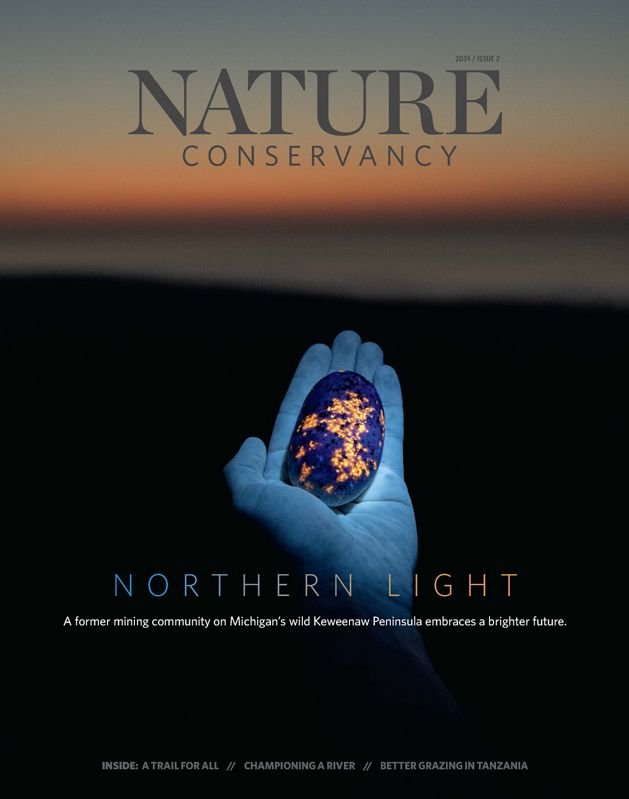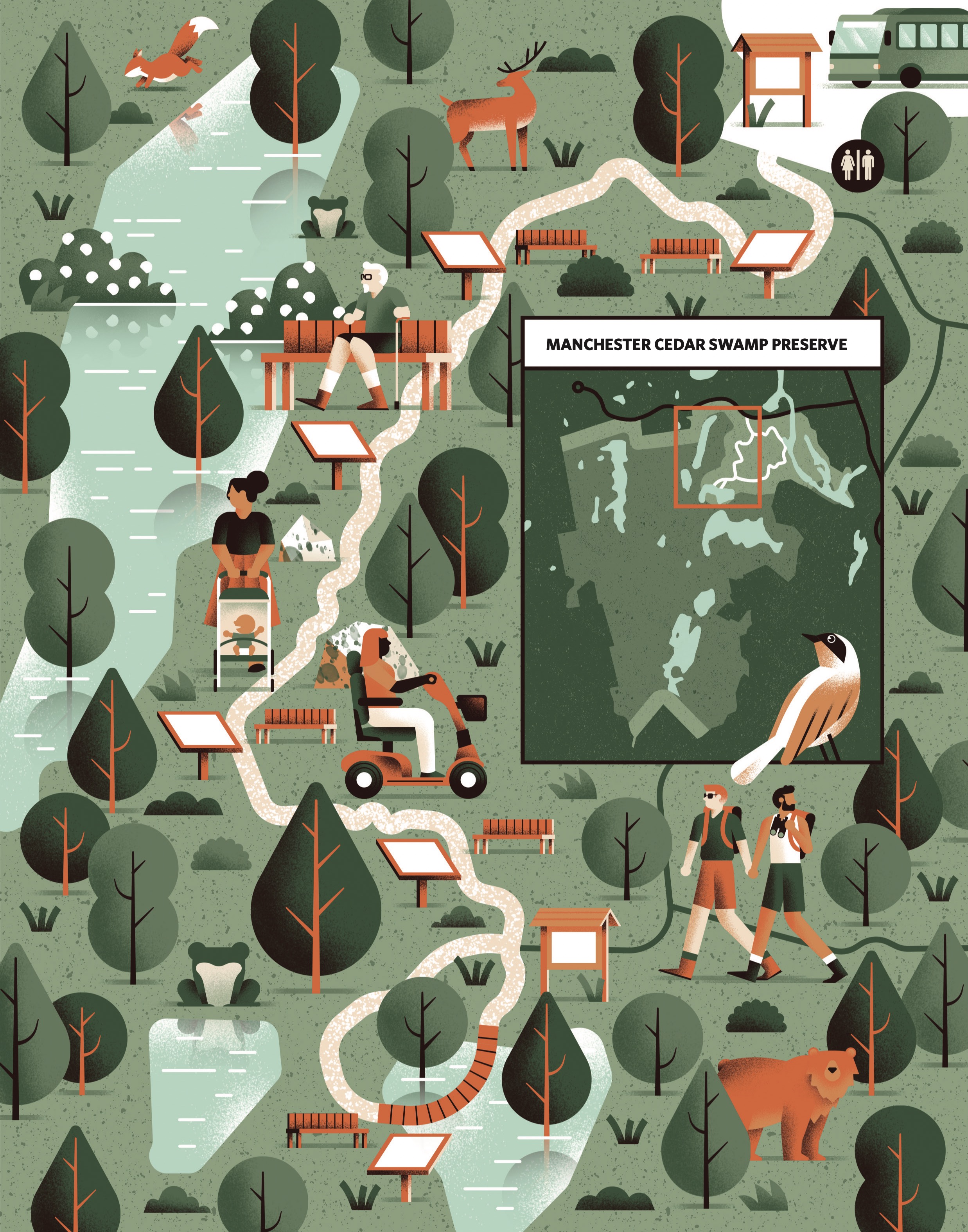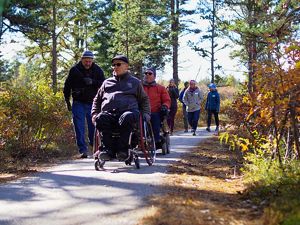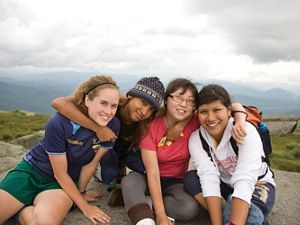
Trails for All
A unique trail project in an urban preserve works to remove barriers to nature.
Text by Timothy A. Schuler | Illustrations by Daniele Simonelli | Issue 2, 2024
A few years ago, Aislinn Graves and her husband, David, posted the first video to their YouTube channel, Wheels in the Wilderness. Over an orchestral score, a Star Wars-style text crawl described the couple’s mission, the yellow letters drifting through space: “After years of being unable to get off the beaten path … Aislinn has decided that she will attempt to visit the White Mountains. With her trusty partner, David, they will try to explore the Lincoln Woods trail, armed only with her manual wheelchair and their grit and determination. Will their efforts end in disaster?”
“Disaster” might be dramatic, but the attempt to hike a scenic bridge in New Hampshire was a bust. After tentatively venturing down the snow-packed trail, the couple turns back. Aislinn, who has used a wheelchair since 1992, says she doesn’t feel safe because of the trail’s incline and the icy conditions. The episode is a poignant reminder of the numerous barriers that exist between experiences in nature and the millions of disabled people in the world. “I’m a realist. I do not expect every single trail to be ADA compliant. That’s unreasonable,” Aislinn says, referring to the Americans with Disabilities Act. “However, we need more. We need an understanding of what resources are available so that people don’t just sit at home and think, ‘This part of my life is over.’”
Nearly eight months later, the Graves uploaded another YouTube video. “We had a very exciting afternoon,” a beaming Aislinn tells the camera. “We were invited to a sneak peek for a brand-new, accessible trail. … Oh, what an absolutely beautiful trail it is.”
The trail in question is the All Persons Trail, a 1.2-mile, out-and-back trail at The Nature Conservancy’s Manchester Cedar Swamp Preserve in Manchester, New Hampshire. Opened in 2022, the gently undulating path guides visitors through thickets of giant rhododendron and dark, damp bogs full of cinnamon fern and rare Atlantic white cedar. Its design was informed by hours of input not just from people with disabilities but from representatives of historically marginalized communities throughout New Hampshire. Now, disabilities advocates and land managers alike are hoping that the All Persons Trail can be a new model for bringing nature to a broader cross section of the American public.
Building a Better Experience
Preserve managers implemented design features, with input from the community, that open the All Persons Trail to a wider set of visitors. © Daniele Simonelli
Getting There
The parking lot was enlarged to accommodate accessible spaces and buses of any size. A Manchester Transit Authority bus stops at the preserve several times a day, making it accessible from the city center. The trailhead features nongendered, fully accessible portable restrooms.
Stopping Points and Signs
Visitors don’t need to travel the entire trail. The path includes benches to rest at multiple points of interest along the way. Signage welcomes users to the preserve. The signs offer lessons about nature, conservation, local Indigenous history and friendly trail etiquette.
Audio
An app-based audio tour makes educational material accessible in two languages, as well as to visually impaired visitors.
Engaging Route
Visitors don’t need to travel the entire trail. The path includes benches to rest at multiple points of interest along the way.
Room To Move
The 6-foot-wide trail accommodates narrowwheeled strollers and mobility devices. Wheelchairs can easily pass on the trail.
Water Feature
A wooden boardwalk traverses part of the cedar swamp. This feature brings people close to nature but also protects the globally rare habitat from damage.
Using community input to make nature accessible to everyone
Picture the prototypical hiking trail: The compacted earthen surface, riddled with rocks and roots or suddenly crossing a stream with only a few stones for steps. For the able-bodied, these details may not even register, but for a wheelchair user like Aislinn Graves, they can mean the difference between a day spent in nature and a day spent indoors.
Like many aspects of the built world, these sorts of trails can feel natural, even preordained. In reality, they are a reflection of the priorities of the trail builders, who historically sought to break down barriers between hikers and the environment, sometimes to the unwitting exclusion of those with disabilities. In recent years, however, conservation organizations and park systems have begun to emphasize accessibility, while also acknowledging that inviting greater numbers of people to preserves carries some risk for plants and wildlife. Finding that balance is worth the effort, says Kate Berdan, the stewardship manager for TNC in New York. “Keeping people out of these spaces isn’t going to help us in the long run,” Berdan says. “The more people we have as stakeholders, the more stewards we have for the future.”
Quote: Randy Pierce
Transportation, especially in a rural state, is the number-one problem.
New Hampshire’s All Persons Trail is perhaps the most tangible example to date of TNC’s efforts to thread that needle and to pilot a process for inviting community input. Led by TNC Stewardship Ecologist Joanne Glode and her team, the idea grew out of an earlier accessible-trail project, completed in 2018 at TNC’s Ossipee Pine Barrens Preserve near Madison, New Hampshire. That trail was a success—visitation quadrupled following the trail’s opening—but the preserve itself is an hour drive from the nearest city. They decided that future accessibility improvements should be located in more densely populated areas and homed in on the Manchester Cedar Swamp Preserve, where 20% of residents speak a language other than English and one in 10 people under 65 live with a disability.
“In the city of Manchester, we have a lot of new Americans, we have a lot of active seniors, and we have a big LGBTQ+ population, as well as a [large] community with disabilities,” says Sheila Vargas Torres, TNC New Hampshire’s former manager of community partnerships, noting that some individuals fall into more than one group.
| By the Numbers | |
|---|---|
7x |
80% |
| The increase in monthly visitors to Cedar Swamp Preserve since the All Persons Trail was opened. | The percentage of preserve visitors who use the All Persons Trail. |
Before designing the trail, TNC organized listening sessions with members of those communities. The conversations highlighted barriers that individuals face when it comes to enjoying the outdoors, which ranged from the physical (not enough benches) to the social (fears of harassment or even violence). One participant spoke about the need for a private space, such as an all-gender restroom, for trans people to bind or unbind their chest. A mother whose daughter has Down syndrome mentioned a need for more frequent places to rest.
One issue that came up in nearly every conversation was transportation access. The Manchester preserve may technically be in the city, but it’s still 5 miles from downtown. “Transportation, especially in a rural state, is the number-one problem,” says Randy Pierce, who lost the majority of his eyesight at age 22 to a genetic disorder. Pierce is now the CEO of Future In Sight, a New Hampshire-based organization for the visually impaired.
For people of color, fears of being alone in nature can be deeply rooted, fed by a long history of racial violence. “Nature is where the lynching happened. You were hung up on a tree,” says James McKim, president of the NAACP’s Manchester chapter. Many Black people still live with fear of violence or harassment in parks and public spaces, a reality that was underscored in 2020 when a white woman in New York’s Central Park called the police on a Black birder, saying, falsely, that he was threatening her after he’d asked her to leash her dog.
After the listening sessions, Glode organized a meeting where TNC reviewed a list of the most common barriers: “We went through and were like, ‘What can we do about this? Anything?’” In a lot of cases, the answer was yes. The final trail design features a 6-foot-wide, crushed-stone path, firm enough for wheelchairs but still permeable to water. New, brightly colored signage includes illustrated depictions of multiple races, genders, sexual orientations and abilities, and explicitly encourages visitors to be respectful to their fellow hikers. An app-based, GPS-enabled audio tour can be downloaded by anyone, including those who are visually impaired or don’t read English. And evenly spaced along the length of the trail are six hand-built wooden benches, including one within view of the trailhead, a visual signal to less-confident hikers. “We never, ever would have considered putting a bench so close to a trailhead if it wasn’t for very specific recommendations that we got from the disability community,” Glode says.
Perhaps the most important accessibility feature is a small, white sign at the far end of the parking lot. It denotes the preserve as a stop on the Manchester Transit Authority’s #11 bus route. “That’s massive,” says Yasamin Safarzadeh, a local arts educator who has partnered with TNC on an arts-and-nature-focused internship for high school students. “Because of that, my unhoused youth are able to take the bus [and experience nature].” The new parking area, which features accessible parking stalls and a gender-neutral, ADA-compliant portable restroom, was also specifically sized to accommodate shuttle buses from a nearby assisted-living facility, which now hosts regular programs at the preserve.
How accessibility benefits all people and conservation efforts
Accessibility is often framed as a niche concern that benefits only a few individuals. But the All Persons Trail, its creators say, demonstrates that accessibility improvements can enhance everyone’s experience. Disabilities advocates call this the “curb-cut” effect. “You put curb cuts in because you want to make sure that people with wheelchairs [can] safely get onto and off of curbs,” says Stephanie Patrick, the executive director of the Disability Rights Center-New Hampshire. But those features, she says, make sidewalks easier for everyone—parents, delivery people, the elderly—to navigate.
Glode points to a new boardwalk at the end of the trail, which replaced a series of narrow bridges made out of flimsy wooden planks. Weaving through one of the preserve’s namesake swamps, this section of trail is arguably the most dramatic moment of the entire experience, with stands of centuries-old Atlantic white cedar and black gum trees. And yet before construction, Glode says, “these little bog bridges forced everyone to look down because they were afraid they were going to fall into the swamp. And I’d be like, ‘Look up! Look up!’ Now, you can walk through and really appreciate the space.” Boardwalks—which keep heavy foot traffic off sensitive swamp soils—are another example of how accessibility can intersect with conservation efforts, creating a level walkway while minimizing damage to plants.
Still, TNC staff say that future investments in accessible trails must be made strategically. At the Manchester Cedar Swamp Preserve, even with the addition of the All Persons Trail, public access is intentionally restricted to a tiny fraction of the property. And Berdan says that in New York, TNC has a goal of completing six major accessibility improvement projects at preserves by 2030. “We don’t want to pave the Adirondacks,” she says, " but we do want people to have some options that don't require hiking steep, muddy streambeds." To help guide such investments nationally, TNC in 2022 hired its first-ever preserve accessibility coordinator, who will provide consistent guidance and technical assistance to preserve managers across North America.
A ribbon-cutting for the All Persons Trail was held on Earth Day 2022. Among the many speakers was Aislinn Graves. She spoke about the mental, physical and spiritual benefits of spending time in nature, and she highlighted the need for more trails like the one behind her. Then she joined the other attendees for the inaugural hike. Reflecting on the experience roughly one year later, she had only one complaint about the trail: She wished it were longer.
Editor's note: Sadly, Aislinn Graves passed away before this article was published. She will be remembered as an advocate for improving mobility on trails.
About the Creators
Timothy A. Schuler is a journalist who reports on the intersection of built and natural environments. He is also an editor for Landscape Architecture Magazine.
Daniele Simonelli is a freelance illustrator based in Rome. He is the founder of a studio collective of animators and illustrators from across Europe.

Magazine Stories in Your Inbox
Sign up for the Nature News email and receive conservation stories each month.







